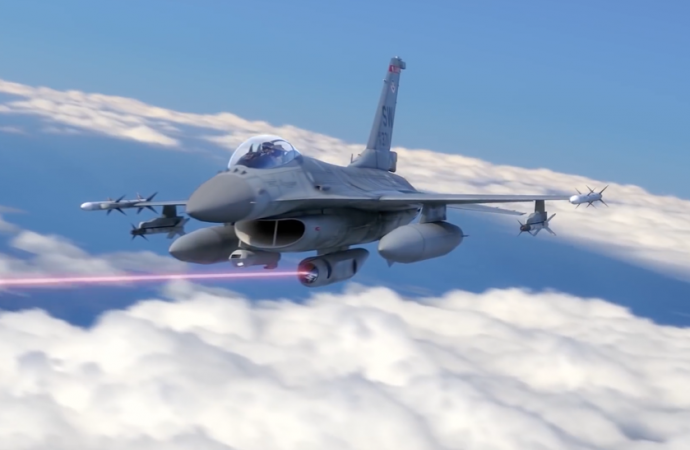Lasers will help older fighters stay alive while flying the deadly skies.
Source: Popular Mechanics
The U.S. Air Force envisions placing laser weapon systems on fighter jets by the mid-2020s. The service is banking on a defense contractor’s TALWS laser system, a pod-mounted laser that will protect fighters from incoming missiles.
The system will likely be used—at first, anyway—to protect older fighters that can’t take advantage of stealth to hide from the enemy. Surprise! Look Out, World: America Has a New Fighter Jet
The system is called TALWS, or Tactical Airborne Laser Weapon System. National Defense reports TALWS is envisioned as a pod-mounted laser developed by Lockheed Martin on behalf of the Air Force Research Laboratory. Mounted on the fuselage or wing of a fighter jet, TALWS could shoot down incoming air-to-air and surface-to-air missiles. Another program, Self-Protect High Energy Laser Demonstrator (SHiELD) will be used to inform TALWS.

Today’s fighter jets are largely limited to passive defenses against incoming missiles. Pilots can take evasive action to try and fly outside an incoming missile’s sensor arc, launch flares to distract an infrared missile seeker, or spread strips of aluminum foil, known as “chaff,” to confuse a missile guided by radar. A laser would be the first real “active” anti-missile defense in the world of air combat, actively trying to shoot a missile down.
TALWS will be a pod-mounted system, meaning it will take up a station on a fighter jet typically reserved for bombs, missiles, or sensor pods. That makes it a bad fit for stealthy aircraft such as the F-22 Raptor or F-35 Joint Strike Fighter, as the pod will break up the plane’s carefully minimized radar signature. That said, both planes already have a missile defense system already built in: stealth technology.

Instead, TALWS will likely go on fighters unable to hide from their adversaries, such as the Air Force’s F-15E, F-15C, and new F-15EX Eagle fighters, F-16 Fighting Falcons, and perhaps even A-10C Warthog attack jets. Trading the ability to carry one more missile or bomb for a laser that could shoot down many incoming missiles is a no-brainer.
TALWS, paired with existing chaff and flare defenses, could very well someday be controlled by an R2D2-type artificial intelligence tasked with defending their warplanes from missile attack.
Lasers will be useful airborne weapons. A laser can be powered by the airplane’s engine, removing the need for an onboard gun magazine and providing a theoretically unlimited number of shots. Laser energy travels at the speed of light, removing ballistics from the targeting equation and making it impossible to dodge.

However, lasers do have a few downsides. Atmospheric effects, particularly water moisture and smoke particles, quickly dilute a laser’s strength. The farther a laser beam travels, the weaker it grows.
Furthermore, the laser must be focused on the fast-moving missile long enough to have an effect. Unlike missiles, whose high explosive warheads deliver a lot of energy in a single devastating explosion, a laser projects a steady stream of concentrated light that heats the target until something fails or explodes. A missile traveling at ultra-fast speeds could prove a difficult target upon which to focus a beam.
A laser defense system like TALWS is harder than it looks. The system must pack the ability to detect, track, and shoot down incoming missiles into a single pod-mounted package. The laser must be powerful enough to fry an incoming missile’s electronics or cause damage to the skin or control systems, inducing aerodynamic failure. The power level of the TALWS laser isn’t stated, but a recent Defense News report says it’s in the “tens of kilowatts.”

This is just the beginning for aircraft lasers. Eventually, a weapon like TALWS will go on almost all warplanes, from bombers to aerial tankers, giving them some form of active protection. As lasers become more powerful, they will become increasingly capable of engaging larger, more complex targets—like enemy aircraft. Lasers will also become useful in engaging ground targets and, some experts predict, capable of shooting down ballistic missiles shortly after launch.
Warplanes have been armed with guns for more than 100 years, but it’s increasingly looking like guns were mere placeholders for laser weapons as the ideal direct-fire aircraft weapon.
While it’s important not to sell the airborne laser as the ultimate weapon capable of doing everything, it does indeed have a very wide array of theoretical uses. But how much of that is actually practical—and affordable? We’ll have to eventually find out.
Source: Popular Mechanics

































Leave a Comment
You must be logged in to post a comment.